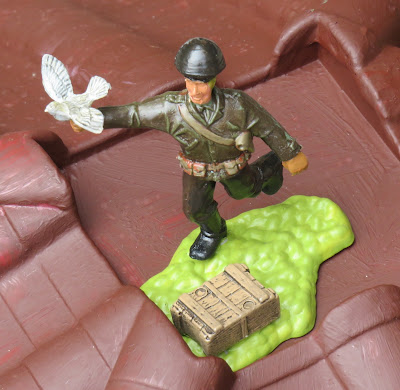Yesterday I had the opportunity to take part in a play-test of the new, inter-war version of Paul Wright's FUNNY LITTLE WARS rules. The action was fought out in an excellent central London location and was set in a not-quite-Spanish-Civil-War setting. It saw the Loyalist forces (of which I was a member) besiege the (imaginary) Alhambra Military Academy, which had been seized by the Rebels and held by a number of Cadet Officers, their instructors, and some members of the Civil Guard.
The Alhambra 'fortress' ...
... formed the centre of the defences ...
... which included a walled garden, ...
... a hospital, ...
... and some outbuildings.
The siege started with a long-distance bombardment of the Alhambra, and this did significant damage to the buildings. (Hits of the buildings are indicated by sticky coloured dots.) At one point, a signaller was seen on the roof of the main building, but at the time the besiegers had no idea of the importance of this incident.
Confident that the defences were now weakened, the besiegers began to cautiously advance towards the Alhambra.
They were met with withering fire from machine gun nests that had been set up in the rubble created by the bombardment.
At this point the Anarchist militia (which had 'acquired' a number of tanks), also joined in the attack on the Alhambra.
The attackers could no longer rely on the support of their long-range artillery, and as they advanced, the besigers began to suffer greater and greater casualties.
The besiegers had almost reached the walls of the Alhambra when it became apparent that their casualties had mounted to such a level that they were uncertain of being able to mount a successful final assault.
At this point, the importance of the signals sent earlier in the battle became apparent. One of the Loyalist long-range artillery positions reported that they could see Rebel armoured cars approaching their position.
Was this an indication that a relief column from the Rebel Army of Africa was on its way?
The battle ended at this point, and everyone agreed that we had had a great time. The rules worked, and we were able to test (and modify) the air combat and bombing rules. (These are not featured in my battle report as I could not take photographs and take part in the air combat and bombing at the same time. However, the following are a couple of photographs of some of the aircraft that were used.)
My thanks go to Paul Wright for organising the whole event and for providing the venue, the terrain and the vast bulk of the toy soldiers we used. Thanks also go to Tim Gow for supplementing the besieging troop with figures from his own collection, and to Ian Drury and Paul's son Jack for playing their parts as fellow Loyalist commanders and for their very enjoyable company. A great day of wargaming was had by all ... and we hope to stage another battle in the not-to-distant future.










































































.jpeg)









